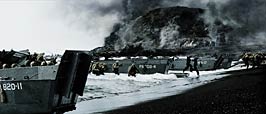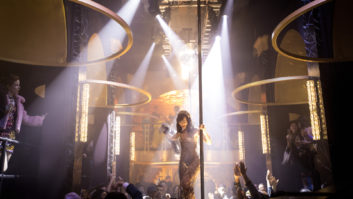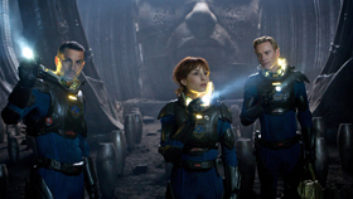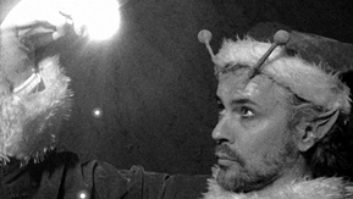
Marines storm the beach in Flags of Our Fathers
Photos: © 2006 Dreamworks LLC and Warner Bros. Entertainment Inc.
Now in his mid-70s, director Clint Eastwood continues to amaze and provoke. His latest artistic (and critical) triumph is a pair of films about the pivotal World War II battle of Iwo Jima. Flags of Our Fathers, released in October, was a deft look at both the intense battle and its aftermath for three of the “heroes” who were part of the world-famous Iwo Jima flag-raising photo and then pressed into service by the government to sell war bonds across the U.S. And the just-released Letters From Iwo Jima (which won the National Board of Review’s honor for Best Picture of 2006) presents the brutal battle from the Japanese perspective: It follows soldiers and their commanders into the island’s extensive network of caves and underground bunkers as they try to withstand an Allied assault that lasted more than a month; it’s almost entirely in Japanese with subtitles. Together, the films offer a powerful glimpse into the psychology of war: the fear and anxiety, the pride, the brotherhood, the bravery and heroism, the guilt — the whole gamut.
Eastwood is famous for fostering a creative and familial atmosphere on his film sets, and he inspires fierce loyalty from the craftspeople who toil away behind the scenes, including his top-notch sound crew, most of whom have worked with the director for many years. Chief among that group are co-supervising sound editors Alan Murray and Bub Asman, both of whom worked as sound editors on the Eastwood vehicle Escape From Alcatraz (directed by Don Siegel) in 1979, and on Eastwood-directed films since the 1980 Bronco Billy. The team that mixed the Iwo Jima films at Warner Bros.’ Stage 10, on one of the new AMS/Neve DFC Gemini consoles, also has a long history with Eastwood: Gregg Rudloff (effects), John Reitz (dialog) and Dave Campbell (music) have all worked on many Eastwood films. (The mixing trio shared a Best Sound Oscar for The Matrix in 1999, and were nominated for The Perfect Storm in 2000. Rudloff also won for Glory in 1989.)
Though Eastwood is a director of great vision and is definitely not shy about sharing his opinions on matters large and small, Rudloff notes that when it comes to sound, “Clint gives you the blank canvas. He has a lot of faith in the people he uses, and with Alan [Murray’s] history of having been with him for so many years, he knows the direction he likes and you learn what his tastes are, so you’re working with that in mind from the start. It’s not like working with a new director and you have to figure out, ‘Does this guy like to hear birds? Does he like the music loud?’”

Flags of Our Fathers/Letters From Iwo Jima mixers, from left: John Reitz (dialog), Gregg Rudloff (effects) and Dave Campbell (music); all have worked on numerous Clint Eastwood films.
It would be inaccurate to call the sonic approach to Flags and Letters as “documentary,” as there are numerous interesting and creative sound design moments. But certainly Eastwood was looking for a gritty realism in both films’ copious battle scenes. The verisimilitude started with good effects recordings, which were helmed by Murray, sound designer Charles Maynes and noted effects recordist John Fasal.
For Maynes, whose resume includes such films as U-571, Lara Croft: Tomb Raider (both earned him Golden Reel nominations for sound editing), Spider-Man and Fantastic Four, Flags of Our Fathers was a film he felt he had to work on: “I had just done The Alamo and The Great Raid, which I had done the battle sequences for, and I was actually over at Fox working on Fantastic Four when I heard that Eastwood was going to be directing Flags of Our Fathers. I had never met Alan before, but I cold-called him when I heard he was doing Flags. I explained that my dad was a career Marine and grew up on or around bases. It’s a real close subject to me. It turns out his father fought at Iwo Jima — he was a tank driver. At that point, we didn’t know there was going to be the second film yet.”
Indeed, Letters From Iwo Jima was shot well after Flags and with a much lower budget. Whereas the battle scenes in Flags were mostly shot in Iceland — an appropriately desolate double for Iwo Jima — Letters was shot outside of Barstow in Southern California, where there were numerous caves and old mines, as well as dark, volcanic soil that matched the look of the real South Pacific island.
“ON LOCATION” WITH WAR MACHINES
Murray did extensive research into the weaponry, planes and vehicles that were involved in the battle, and then he, Maynes and Fasal set about recording them. “In L.A., the two dominant shops where you can find just about any kind of weapons are ISS — Independent Studio Services — and Gibbons Limited,” Maynes says. “They have literally thousands of weapons, spanning from flintlocks all the way up to the most modern stuff.” The Marine base at Twentynine Palms in the Mojave desert east of L.A. provided the setting for recording vehicles, heavy artillery and explosions. Locations in Paso Robles were employed for the World War II aircraft. Weapons fire was captured in a couple of sessions in Burro Canyon and other locales closer to L.A.

Marines travel across the desert while large-caliber mortars pound the earth in Flags of Our Fathers
“John, Alan and I went out on all the weapons shoots,” Maynes continues. “The machines we used were the 744 Sound Devices — the 4-channel [digital] recorder; John had two of those and I tend to take out two, as well. Then John, myself and Alan had four FR-2 Fostex machines, and John also brought his older Nagra, which he really likes. I’ve sort of lost my enthusiasm for that because of the noise floor. But I think the Sound Devices sounds really good. All the digital stuff was recorded at 96k. As for mics, well, we used everything you can imagine: Sennheiser 416 and 816 [shotguns]; I think we had an MKH-70 [Sennheiser long shotgun] out and I use a Sanken CSS-5 [stereo shotgun], too. Dynamics pretty much ran the gamut from SM57s out to the Shure B52s and the Sennheiser 441s. We were also using Crown SASS heads, which are really nice, and John had a wide array of mics, as well, including DPAs and some of the newer high-res Sennheisers.”
As is typical of these sorts of sessions — which employed up to 20 channels — shots, whiz-bys and impacts were covered from multiple angles and distances. The effects were then moved over to a Mac and eventually delivered to the stage (Steve Pederson mixed some of the battle predubs) as Pro Tools files at 48 kHz, “which reduced the volume of space that was required,” Maynes says. One of the bigger challenges was “this very, very large-caliber mortar the Japanese used, which projected a shell that was 250 pounds. They called it the ‘flying dust bin’ [garbage can]. There aren’t any of them that are still working, so that became a design project. We had artillery elements for the shell traveling through space, and for the actual projection of it, we used a mix of some of the field artillery we had recorded, as well as some mortars I had recorded for [the videogame] Call of Duty, which were then digitally processed.”

The sound crew captured a more “claustrophobic” music sense for Letters From Iwo Jima.
Photo: Merle W. Wallace, SMPSP
“In general, though,” Murray says, “we wanted to remain truly authentic to the weapons and the battle.” That sentiment also carried over to the ambiences that were developed for the scenes on the war bond tour. “It was important that the trains and traffic and all the details be authentic,” he adds. “Fortunately, I’ve done a lot of period pictures, so I have a pretty big library to draw from for that. Also, [in Flags] there’s a lot of sound design flashback material that we had to come up with, too. For that, we used a lot of low-end tonal things, making you feel the effect of going in and out of the war [as the scenes shift from battle flashbacks to the bond tour]. We have things like mortars coming out of thunder, and the sound of the waves washing out the [dead] Marines and then turning that into a sound to bring us out of the war.”
DIFFERENT FILMS, DIFFERENT FEELING
Asked about differences in tone between the two films, Rudloff offers, “In Flags of Our Fathers, the battle scenes are much more open and large in scale. The action in Letters has some big moments, like when the Allied planes come in and attack their camp, but much of it is much more claustrophobic in nature, and we were trying to impart the terrific stress these [Japanese] soldiers were under because they had no relief from the bombing. One of the most challenging aspects for us in Letters From Iwo Jima is because the invasion takes place fairly early in the movie, you then have to continue this battle for the entire duration of the film. There are moments of utter chaos where the soldiers are enduring the bombardments in the caves and wondering if the caves are going to collapse around them, and other moments where we’re trying to be more intimate with characters and you don’t want an in-your-face battle going on. At the same token, you can’t let the audience forget we are in a major battle. So a lot of care was taken with varying the sound of the battle depending on the setting and what was happening in the scene. The quality of the recordings Alan got for the distant battle [sounds], whether it was small-arms fire or the artillery, or what we refer to as ‘crumps,’ which are distant explosions, add incredible texture and emotional feel to the movie.”

Supervising sound editor Alan Murray
“We also had to feature different depths in the tunnels,” Murray adds, “so when we were with the [Japanese] generals, we wanted the battle to be omnipresent, but not a threat really. So we had different levels of where the battles were.”

Hovering near a 60mm mortar is a Heil PR40 mic.
Photo: Charles Maynes
Dialog mixer John Reitz had worked on foreign language prints of major Hollywood films before, but never on one that is mainly in Japanese to begin with. Did it change how he worked? “Yes, because there are certain things you do routinely in an English-language show that I couldn’t do here. There are certain little ‘esses’ and things I would normally take out or work with, but you have to be really careful on the Japanese dialog because I couldn’t understand it.”
Rudloff adds, “The technical aspect of what John was doing with the dialog was the same, as far as cleaning up the noises that are inherent in making a movie — camera noise, generators, lights, things like that. But creatively that’s where we had our greatest concern, because when you’re dealing with English, you not only understand the words, you understand the meanings behind them. In Flags, when we’re in the middle of a huge battle scene, to help convey the chaotic nature of battle, we were not allowing the audience to understand all the words. Even though a lot of people are yelling, you’re only able to pick out a word here or there. But knowing the language, we knew which words were important to understand. In the like situation in Letters, we couldn’t do that. What we did was we had Japanese interpreters there in the process of making the movie — both before it ever reached the mix stage, and then once we mixed the movie — we played it for a Japanese interpreter. And we also had a couple of gentlemen from Warner Bros. Japan here, and they watched the entire movie and they were able to tell us if they had any issues with the language.”
THE EASTWOOD INFLUENCE
Fitting in the music for the films was relatively straightforward for mixer Dave Campbell, made even easier by the fact that it was scored by Eastwood himself — the director is a well-known jazz aficionado and has frequently been involved with scoring his past films. “We played everything he wrote,” Campbell says with a chuckle, “and then he had the choice of what to leave in and what to take out. But it was such a minimalist score; it was very simple for me. It was done by Clint and his son, and their friends, and developed at home. They had worked it out about 90 percent before it was given over to Lennie Niehaus [who has composed for a number of Eastwood’s films, including The Unforgiven and The Bridges of Madison County] for any additional orchestration.”

Japanese machine guns and other small arms were captured from multiple angles in a canyon east of Los Angeles by the recording team of Charles Maynes, John Fasal and Allan Murray.
“Clint’s not the kind of filmmaker who’s going to make you play a piece of score just because he wrote it,” Rudloff notes. “There were times in both movies where choices were made to take music out because he felt it wasn’t adding anything to what he was trying to tell at that point. He’s a very fair-handed director in that way. He’s trying to tell his story in a certain way and whatever helps him is what he does, whether it’s dialog or music or effects.”

Charles Maynes collects sounds near Waco, Texas, with a Fostex FR-2 and Sanken shotgun mics.
Photo: Teresa Maynes
Unlike on most major films these days, “There are no temp dubs with Clint’s pictures,” Murray says. “When you show up, you’re ready for battle. You don’t have a lot of experimentation time. Generally, early on I’ll have a run-thorough with Clint and then I express what I want to bring to the movie, and it’s kind of like jazz — it’s almost free-form until he gets on the stage, and then he doesn’t want any particular influence dominating the sound job. So you have to be covered on all bases and have everything you might need.”
“We try to keep great separation in all our material so we have the flexibility to go in various directions,” Rudloff says. “That’s something we do on every film, but it’s more important in a situation like this where you haven’t been through the traditional process of temping it several times and ironing out which sounds are appropriate or chosen by the filmmaker.”
At this point, Murray, Asman and the mixers are so locked into Eastwood’s tastes and methodology that they rarely experience any major snafus on the all-important final. “More than once,” Reitz notes, “we’ve dubbed reels and Clint has come in, and said, ‘Well, that’s fine. Let’s go on to the next reel.’ Trust me, that does not happen very often anyplace else.”
Blair Jackson is Mix’s senior editor.




